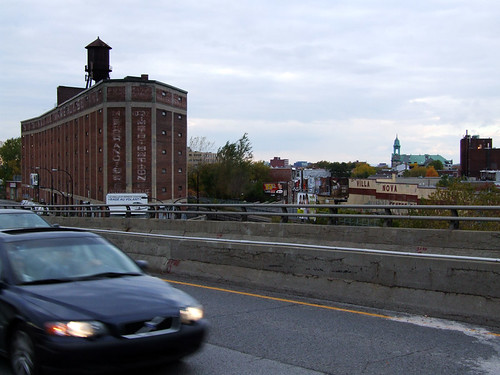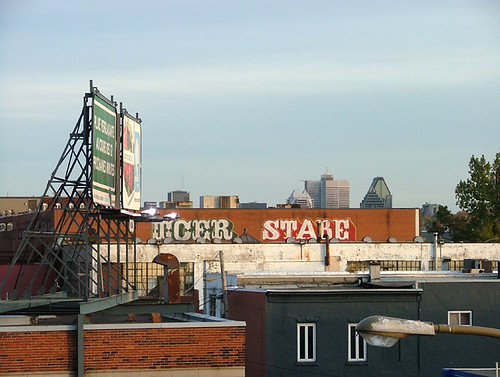WHAT? Ideas for the Van Horne/Rosemont viaduct and its surroundings
WHERE? Dare-Dare’s art space at St. Laurent and Van Horne
WHEN? Tuesday, April 29 at 8:30pm
Earlier this month, on the year’s first truly warm evening, I needed to get from my apartment to Rosemont metro, the closest orange line station. I decided to walk, which involves a pleasant saunter down Bernard Street and a stroll over the Van Horne Viaduct, also known as the Rosemont Viaduct, which bridges the CPR tracks and brings you straight from Bernard to the metro. It had been awhile since I had made the journey and, when I climbed up the stairs to the top of the viaduct, a familiar feeling struck, and I was reminded that it is one of the most romantic places in Montreal.
Walking across the viaduct in still, humid air, I looked around. Garment factories, warehouses and old factories loomed in the distance; church steeples and bell towers rose above a jumble of bare trees and messy rooftops. In the west, I could see the Université de Montréal’s tower perched on the edge of the mountain. To the south, I gazed beyond St. Michael’s minaret-like tower to Mount Royal and the tops of the downtown office towers, floating above the crest of the hill like buoys in rolling water. “Stare,” commanded a tag painted on the side of an apartment building.
It’s amazing how an ordinary piece of 1970s infrastructure, designed simply to transport cars and pedestrians from one side of a railroad to the other, could have introduced such an extraordinary perspective on the city. Walking across the viaduct has the same revelatory effect as climbing atop a roof: there’s the same feeling of surprise as you reach the crest of the bridg and gaze out at what is invisible from the street. It is somehow unexpected to see everything in its place. The city begins to make sense.
Now that Quebec is officially afraid of overpasses, though, what will happen to the Van Horne Viaduct? Dare-Dare, the arts centre located almost underneath it in the “park with no name,” has teamed up with urban designers and architects from McGill and the Université de Montréal to host proje(c)t(ions)s urbain(e)s, “an evening of imaginations/projects/visions” for the viaduct and its surroundings. Here’s more from Dare-Dare:
Aging pieces of urban infrastructure create both problems and promise for the city. They are in one sense destructive — they disrupt the urban fabric, they make inhabitation difficult. Yet they are also profoundly creative — they tend to serve as the friches or fallow lands from which the city renews itself. One such site is the braid of roadway and rail-line formed by Rosemont viaduct and the CP railway beneath it.
The evening presents the work of three design studios which have recently examined this potential in sites and spaces around Rosemont viaduct. Each studio has approached the viaduct from a slightly different angle; the result is a diverse array of visions of urban design, architecture and landscape. These visions will be projected onto the viaduct itself, bringing the students’ ideas back in contact with the urban artefact which inspired them. All are welcome.



3 comments
I love the view from up there. Yes, overpasses are cumbersome, but in cases like this they actually add some character to the urban fabric.
The view from this overpass is one of the most spectacular in Montreal, with excellent views of Parc Mont Royal summit and Mont Murray (outremont) summit, and the surrounding neighbourhoods.
There are stairs that lead up from boulevard St-Laurent offering easy access: just a few stairs to a world-class view
This is one of my top Montreal secret-scenic-lookouts.
I agree the view is amazing. There’s a workshop/factory whose roof practically juts up right next to the top of the overpass. I’ve always wondered what they make in there. Does anyone know?